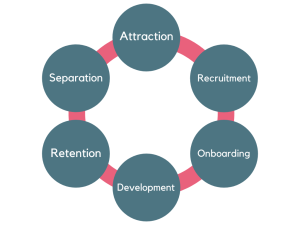New challenges for employers are cropping up every day, from recruiting new employees to retaining current ones. Recent trends show that employees want more from their jobs, and when these needs aren’t met there is more reason to go looking elsewhere. The task of finding a skilled candidate pool to shortlist applicants from is becoming increasingly hard, but where are all the skilled workers going?
It isn’t that the skilled and qualified are disappearing, nor is it that the loyal employee is a rare breed. Instead, it is the need for companies to adapt and evolve. This article presents ideas on how companies can position themselves in a way that will attract the right candidates, as well as give advice on different ways to recruit. Also, the importance of employee retention is analysed and routes identified, on how to use a combine new trends such as flexible working with key principles like engagement and wellbeing, to lower employee turnover and strengthen retention.

The employee life cycle
The employee life cycle explains the six stages individuals go through, during their time with a company. Attraction, Recruitment, Onboarding, Development, Retention and Separation. All six represent a different relationship the employee has with an employer and through each stage, employees interact with the company on a different level, all of which form the employee experience. With a focus on Attraction, Recruitment and Retention, this blog explores new trends, offers advice, and gives top tips on how to acquire and keep the best employees.
Attraction
This is the first point of contact you will have with future employees, and, in terms of recruitment, this initial interaction is vital. Attraction occurs in several ways, starting from the basics such as well-crafted job adverts, to candidates seeking out your company due to a good corporate image. It is important that your company appeals to the right type of candidate, those that fit with your company values.
When attracting candidates, it is important to ensure the position, salary, and benefits are fair, competitive and in line with the market sector/industry your company is in. However, these are not the only important factors individuals are looking for. Employer branding is vital.
Tips on how to attract the best candidates:
1. Organisational cultural development
This is one of the first things that can help attract top talent. Through aligning your organisation’s values, mission, vision, and goals and promoting positive company culture, individuals will be drawn to your company. Although an indirect route to attracting employees, a strong culture can be key in recruiting highly skilled and loyal employees.
This culture should not just be developed internally, but also promoted externally, so those outside of your organisation can see your business culture. This can be via the company website, social media, being involved in external social/environmental causes or, having articles written about the organisation on third party websites. The more publicity there is around your organisation’s culture, the more people will know about it. In addition, employees who work/worked in a company with a positive culture are likely to pass positive feedback on, whether that is to personal networks or on media platforms such as Glassdoor. Be an employer of choice.
2. Recruit and develop internally
Not all attraction needs to happen outside of the company. When looking for qualified, committed, and loyal employees, sometimes they are right under your nose. Looking at your current employees and putting effort into training and developing them for new roles is beneficial in a number of different ways. For example, it cuts recruiting costs, promotes a learning culture and increases employee engagement.
3. Employee referral programmes
This can be a great way to increase your candidate pool, and by having current employees championing candidates increases the success rates of new employees. Not only this but by having employees help fill new positions, it can improve their personal connection to the company and increase their commitment. These types of programmes usually offer incentives but also recognition for any successful hire that’s made.
4. Networking and relationship building
Networking with other companies provides a wider understanding of what others are doing for their own staff. By comparing and exchanging ideas you may gain insight into new ways to gain, retain and engage employees. Relationship building with different institutions such as colleges and universities is also a great way to attract new, eager minds to your organisation. If your business is wanting to engage with the development of entry-level employees such as interns, graduates, or apprentices, this route to attraction could be key.
Recruitment

Once you have attracted the right candidates, the next hurdle is the recruitment process. You want to provide a positive candidate experience. With the new way of working being remote or hybrid, a remote recruitment process is something candidates may well be used to, but the need to engage them is still a priority. The type of employment an organisation is looking for is also important. With different types of employment such as permanent, full-time, part-time, seasonal, apprenticeships/internships and more, it is vital companies are aware of the variations of employment type. With low unemployment rates and currently, the highest number of vacancies in the UK since records began, individuals have choice and flexibility in the types of job they are looking for.
There is now less of a focus on a career for life, as employees are changing jobs more rapidly and wanting more from their employers. In many cases, people want to be able to have more than one profession. More non-traditional jobs are on the rise such, as casual and seasonal roles alongside more apprenticeship and intern jobs. All of this has increased the importance of flexibility in jobs, and this is something employers should take into consideration when recruiting.
Tips to keep in mind when recruiting:
1. Don’t overcomplicate it
Although it is important that you find the best candidate, you don’t want an extremely lengthy recruitment process, which is tedious for both you and the candidates. So, lower the use of lengthy forms, processes and repetition in the application stage and make use of new ways to recruit.
These are methods such as mobile recruitment, obtaining short videos from candidates and targeted advertising. If you’re looking for employees in a particular demographic, advertise the jobs in places you would expect them to be. For example, if you’re looking to bring on board a social media whizz, advertise your vacancies on relevant social media platforms. Use the resources available to you, which are often very low cost.
2. Keep candidates engaged
There are a number of ways to keep candidates engaged throughout the recruitment process, which if deployed will increase engagement not only during recruitment, but also throughout the employee life cycle (in the right conditions). These include keeping communication personalised and not sending out generic emails. The next is building a good relationship with the candidate from the offset, even if this means spending some extra time in an initial phone interview. Finally, build a value proposition for the candidate by explaining and demonstrating what your company can do to help them achieve their professional goals.
3. Remain transparent
It can be extremely frustrating for candidates when they are left in the dark. It can cause a negative relationship and can cause candidates to look elsewhere. It is important that you communicate clearly with each candidate about where you are in the recruitment process and keep them updated with the remaining steps. Remain honest with them and provide regular feedback throughout, and most importantly if you give a deadline for a decision, stick to it.
Alongside transparency, it is also important to be honest when talking about the job being offered and the company itself. Don’t oversell anything just to acquire a candidate as down the line it will only lead to disappointment on both sides.
4. It’s okay to ask for help 
No one said finding the right candidate to fit your vacancy was easy, and sometimes it can be frustrating to go round in circles. So, you should know there are lots of providers out there who specialise in recruiting for organisations! Whether you are just looking for some extra advice or, want to outsource it completely, there are a number of avenues and SYLO | Beyond HR. can guide you on this. We can also take care of the recruitment for you!
Retention
Employee retention is all about holding onto your employees, so your employee turnover remains low, and you don’t need to continuously spend money on recruiting and training up new staff. Retention can be built up by focusing on a number of different factors.
1. Organisational Culture
Just as organisational culture can attract employees to your company, it can also keep those who already work for you if they get more from their job than just financial reward. Company culture and ethics, its attitude towards social and environmental factors are also a strong draw for employees to feel loyalty and pride for the company they work for. By incorporating a strong corporate social responsibility strategy, you can improve employee retention as well as boosting the overall reputation of your company.
2. Employee wellbeing
Taking an interest in looking after your employees, mental and physical health can also help with retention, as employees need to feel valued and cared about. In the current climate of remote and hybrid working, employee wellbeing has never been more important. Not only is this good for employees but increased employee wellbeing provides increased team focus, positivity amongst teams, higher performance levels and higher levels of productivity.
Just like a good organisational culture, a focus on employee wellbeing will also bring about further benefits such as improved company reputation, which in turn will attract great talent.
3. Professional development
Providing your employees with development opportunities to grow their skills and career through professional development plans and training is another great way to retain employees. When employees see their employers investing in their future and allowing time to improve their skillset, it builds a strong relationship between employee and employer. Employees are more likely to stay at a company that encourages and supports their support their development.
Steps that can be taken to aid professional development include regular 121s, performance reviews and career development conversations around future goals and succession planning, and offering training and professional development.
4. Flexibility and hybrid working

With COVID-19 changing the way everyone works, flexibility has become a huge part of how we all work. Managing this correctly to ensure employees are satisfied with their working arrangements will play a big part in employee retention. Whether this includes a change in working time or location or different types of flexibility in terms of the roles employees carry out. Alongside flexibility is hybrid working, which has meant employers need to put in place new rules, regulations and policies around how employees carry out their daily duties. It is hard for any company to get used to the changes which will undoubtfully influence how we work from here on out, so it is good to be aware that there are companies such as SYLO | Beyond HR. who are available to help, advising companies in ways to incorporate flexible and hybrid working into their day-to-day operations.
This, alongside the help of creation of new policies and procedures, can help shape your organisation internally and keep you up to date with new trends.
For a summary and recruitment tips on the go, please download our PDF booklet on recruitment.
Further Support:
Below are links to just a few of the external resources which are available to you and your business to help with recruitment.
- Apprenticeship resources
- Growing your business- hire and train staff
- Employing prisoners and ex-offenders
- Recruitment and induction
- Glassdoor
- Recruitment checklist
- Lindengate Mental Health Charity

Written by: Maggie Armstrong-Gaisford